Palermo tourist information
Palermo is Sicily’s regional capital, fascinating, filled with history and full of life. On the north-western coast of the island, it’s a busy port city with an international airport and many will begin or end their tour of Sicily here.
- Sicily destinations and practicalities: full menu (at foot of this page)
In the Middle Ages, Palermo was one of Europe’s leading cities, but nowadays the town is still recovering from twentieth-century years of blight. With some glorious historic buildings, vibrant, scruffy markets and a sunny climate, Palermo is doing a fairly good job of shaking off its reputation within Italy as a hotbed for both petty and organised crime. While areas of the centre are still run-down, and occasionally – along with the traffic – somewhat alarming, Palermo also has bohemian boutiques, famously-excellent street food, fine architecture (frequently crumbling) and a lively atmosphere. The city is not somewhere I’d spend a long holiday, but a short break here, or a few days as you begin or end a tour of Sicily, is a rich and rewarding experience. There are easily three or four days’ worth of attractions in and around Palermo, though you can see the highlights in a day. The city has good transport connections and a number of marvellous excursion possibilities, including mosaics at Monreale, an island trip to Ustica, and the beach at Mondello.
> Find somewhere to stay in Palermo
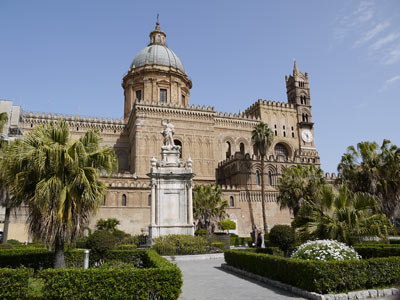
Tourist sights
Although at first sight Palermo isn’t an obvious tourist city, it rewards the self-motivated tourist with some grand scenery, good cheap food and some fine art. Preparing yourself with a map and a spot of research before going out exploring really pays off here. For travellers exploring Sicily’s history, this is an important stop on a tour of the island and there are several unmissable sights. It’s worth noting that Palermo is a stopping-point for cruise ships, and so it’s not uncommon to find crowds of inappropriately-clad tourists being led around by guides at central sites; you may encounter queues at the Palazzo dei Normanni and La Martorana in particular.
Central Palermo can be toured on foot, and the best place to start in the morning is with a walk through one of its lively street markets, followed by an overview of the city from the roof of the historic cathedral. Palermo’s chaotic and bustling markets are famous and the range of products on offer – seafood, colourful fruit and vegetables, random junk – makes for a fascinating wander. Early morning is the best time to visit. The biggest markets are Ballarò, Capo and Vucciria. The latter, in the back streets around Piazza San Domenico, features heavily in Peter Robb’s book Midnight in Sicily. The crowded, noisy lanes of the markets can be overwhelming; I’d recommend checking a map closely beforehand so you know where you’re going, and keeping valuables secure and out of sight.
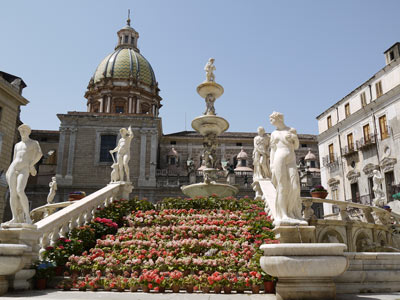
Palermo’s Cattedrale has the most impressive, and the most confused, exterior of all the city’s buildings. Much of the current cathedral was built in lavish Arab-Norman style under Sicily’s Norman rule in the twelfth century, though the building has seen many modifications since, including the addition of a fifteenth-century portico and an eighteenth-century dome. Along with a handful of other Sicilian buildings, it is part of a UNESCO World Heritage listing: Arab-Norman Palermo and the Cathedral Churches of Cefalù and Monreale. The main part of the church’s Neoclassical interior (c.1800) is free to visit, but there’s a combined ticket for the far more interesting “Monumental areas”: Crypt, Treasury, Royal Tombs and Roof. Here you’ll see the royal tombs of medieval Sicily, including the porphyry sarcophagus of the remarkable Frederick II, known as Stupor Mundi, the Wonder of the World.
The climb to the cathedral roof is up a steep and narrow spiral staircase with high steps; there are frequent escorted tours. The view from the roof is splendid, both of the details of the upper parts of the building itself (look for the carved faces and the shining tiled domes) and for the context, looking out over the city. Palermo’s setting is striking and from this vantage point you can see what made this spot so appealing to early settlers: a fertile plain protected by a curve of steep-sided hills and open onto the sea. Note that the climb and exposed walkways of the roof are not for the unfit or nervous. The cathedral’s treasury contains the pretty jewelled crown of Constance of Aragon, first wife of Frederick II, along with her rings, which were removed from her tomb. The gloomy and dank crypt houses urns and tombs going back to the Roman era, some of them very fine.
Up the road from the Cattedrale, and part of the same UNESCO listing, the Arab-Norman-Spanish Palazzo dei Normanni (or Palazzo Reale) provides a fabulous lesson in the grandeur of Norman Sicily. A former royal palace added to and altered over the centuries, this is now the seat of the local parliament. Parts of the building can be visited, including the Cappella Palatina, an exquisite chapel containing rich twelfth-century Byzantine mosaics. Check the opening times in advance (see links panel on the right) and be prepared to queue at busy times.
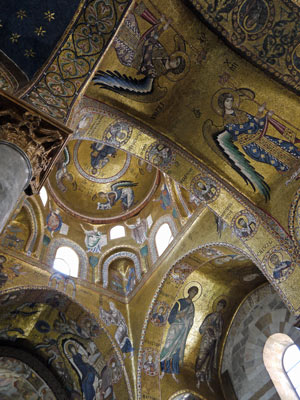
Central Palermo is bisected by a long straight street, Corso Vittorio Emanuele, running inland from the seafront to the Palazzo dei Normanni. It’s crossed by two other important, parallel streets, Via Maqueda and Via Roma, which leads to the railway station. The crossroads of Via Maqueda and Corso Vittorio Emanuele, the Quattro Canti, counts as the heart of Palermo, and is dressed in grand Baroque architecture to fit the spot’s significance. Close by is another architectural hotspot, Piazza Bellini, a small square boasting two important twelfth-century churches: San Cataldo and La Martorana. Both churches have small entrance fees, with a discount if you visit both.
The Arab-Norman-style San Cataldo has an unusual exterior with three red domes, and its interior is an exquisite little columned-and-arcaded space, with a lovely mosaic floor. La Martorana, by contrast, has a lavish gold interior, with its walls and ceiling covered in gleaming mosaics, best seen when morning rays of sun pierce the interior. Look out for a scene of Roger II, in Byzantine dress, being given the crown of Sicily by Jesus. There are various amazing mosaics in churches in Sicily and around Palermo, including Monreale and Cefalù, but if you’re pressed for time, La Martorana is a convenient central place to admire the artistry of Sicily’s Byzantine craftsmen. After visiting these two churches, don’t miss the huge fountain in Piazza Pretoria alongside, which resembles a stage set, with nudes carved by a very robust-minded sculptor (in fact the fountain was dubbed the Fountain of Shame).
As well as churches and palaces, Palermo has some good museums to visit, including the Galleria Regionale in Palazzo Abatellis (closed Mon and Sun), and the fine Museo Archeologico Regionale, which contains exhibits from the famous archaeological sites in western Sicily. There’s a modern art gallery in the Kalsa district, called the Galleria d’Arte Moderna (GAM), an ethnographic museum and a number of other specialist museums and galleries.
For a taste of the old, aristocratic Palermo, a good place to visit is Palazzo Mirto, a stately home museum in the heart of town (closed Mon). There are some combined tickets available for sights, so take a look at the ticket information before you pay to enter your first museum, as well as confirming opening times before you go.
For those with more specialist interests (and strong nerves) it’s worth making a trip to the macabre catacombs of Palermo’s Convento dei Cappuccini, where mummified corpses dressed in their Sunday best line the walls in an unusual and very Sicilian approach to commemorating the dead. A bus ride or walk from the centre of town, this bizarre and poignant sight is treated by its more insensitive visitors as a novelty freak-show. However, it provides an unforgettable insight into the Sicilian attitudes to life and death, and the thought of bereaved families coming here to sit and ‘chat’ with their departed loved ones is deeply moving as well as surreal to outsiders. The website of the Capuchin Catacombs (see links below) has detailed information and directions.
One of Sicily’s greatest buildings is just a short bus ride from the centre of Palermo: the cathedral at Monreale is famous for its Norman architecture and for the vast Byzantine-style mosaics which cover the interior. For a very different excursion from the city, take the bus to Mondello, the beautiful sandy beach where Palermo’s residents flock in the sunshine.
Other sights include the city’s imposing opera house, Teatro Massimo, which opened in 1897 and is open for guided tours as well as for opera performances. Plays acted by marionettes are a local tradition, and you can visit the Puppet Museum (Museo delle Marionette) to learn more about the history of the art – and see a performance if you can. If you have time to wander, you’ll find some interesting artisan type boutiques and a bohemian atmosphere on Via Paternostro, close to the Antica Focacceria di San Francesco (see below). Walking down to the seafront is mildly interesting, no more, but you’ll find a popular park at the Foro Italico and you could check out the flea market around Piazza Marina or visit the gardens of Villa Giulia and the Orto Botanico.
Palermo has a handful of tourist information offices around town including an office at Via Principe di Belmonte, 92, a kiosk in Piazza Bellini and another by the port.
For more background reading, John Julius Norwich’s writings on the Normans in Sicily and Peter Robb’s Midnight In Sicily
provide a lot of context. If you read Italian, I’d recommend the entertaining Palermo è una cipolla
by Roberto Alajmo, a quirky insider view of “onion-like” Palermo.
Food and drink
Palermo’s a great place to eat authentic Sicilian dishes, including street food, at reasonable prices. Around the markets you’ll find stalls selling fresh food and snacks, including local specialities like pane e panelle (chick-pea-flour fritters in a roll). Popular places to eat include include these stalls and little obscure hole in the wall restaurants. If you’ve read the book Midnight in Sicily, you’ll probably want to search out the Santandrea in Piazza Sant’Andrea, just off Via Roma. This tiny square can be lively at night with drinkers and street-food stalls. Palermo, though, is full of good places to eat, mostly small, under-the-radar and unpretentious.
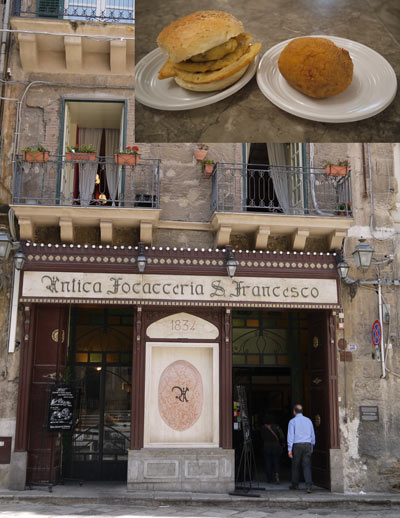
One of the best-known places to eat in Palermo is the Antica Focacceria San Francesco on Via Paternostro. Dating to 1834, this the classic place for street food which you can take away or eat in the old-world interior. Pay at the till before stepping up to the food counter and ordering your food; there’s a menu and price list on the walls. Local specialities you can try here include pane e panelle and arancine with a choice of filling. Elsewhere you may have encountered arancini; the masculine noun arancino is, for inscrutable reasons, feminine in Palermo. The marble tables on the ground floor are for take-away customers; upstairs is for table-service meals (less highly recommended by past diners; I’d stick to the take-away counter).
If you’re vegetarian or looking for something a bit different, you could try a meal at Freschette (Via Quintino Sella), a small good-value restaurant with a modern feel which specialises in organic produce. When I last visited a few years back the menu was all vegan and vegetarian, except for one dish which had optional salami. The desserts were delicious. Food is heavily focussed on locally-grown specialities, and the wine list includes organic Sicilian wines. Another place worth a try is Cibus, a speciality food-store-cum-restaurant near the port at Via Principe di Belmonte, 23.
Another option that makes a change from the tourist norm is an inclusive migrant-led social initiative founded in 2014. An evening restaurant and a co-working space are key elements of Moltivolti’s project, promoting food as a means of dialogue between different cultures. Expect a range of dishes from African, Sicilian, Mediterranean and Middle Eastern cuisines, with vegetarian and vegan options. They also run a gelateria, BarConi in the Ballarò district.
In the heart of town, near the archaeological museum and Teatro Massimo, and around Piazza Olivella and Via Monteleone, you’ll find some lanes of tourist-friendly restaurants. For a convenient and hearty simple meal, I’d suggest asking your hotel or B&B to suggest a good neighbourhood trattoria; there is probably a decent, unpretentious place to eat only a street or two away.
Travel to Palermo
Palermo is also a good, practical staging point on a journey, with ferries to the picturesque island of Ustica, and trains and buses to other Sicilian destinations. Public transport in Palermo is run by a company called AMAT. If you are travelling out to Mondello or Monreale you will find their buses useful.
Palermo has an international airport situated along the coast to the west of the city. The airport bus to Palermo, run by a firm called Prestia e Comandè, is brisk and efficient, running approximately half-hourly, and taking 50 minutes to reach the Stazione Centrale in Palermo, with stops throughout the town centre. You can buy tickets in advance online, at the airport ticket office or on the bus. The airport is named Aeroporto Falcone e Borsellino after Sicily’s Mafia-fighting prosecutors Giovanni Falcone and Paolo Borsellino, both murdered for their efforts. On the drive into Palermo you’ll pass the spot where in 1992 a Mafia bomb blew up Falcone’s entourage, kiling him and several others.
Palermo also has a railway station, and although trains within Sicily can be winding and slow, there are actually direct trains to Palermo from as far away as Rome (see the Transport section). The city’s main station is Stazione Centrale. Ferries from Genoa, Naples, Sardinia (Cagliari) arrive and depart from the docks of the Stazione Marittima. There are also hydrofoil services to Ustica and a once-daily summer service to the Aeolian islands. Bus services from Palermo run out to the neighbouring towns and countryside; often this will be a quicker option than taking a train. It’s best to avoid driving in the chaotic city, if you can.
Palermo accommodation
Palermo accommodation varies widely in price and luxury, although you should be prepared for slightly lower standards of hotel than you might find in a quieter and more ‘touristy’ resort. A recent wave of B&Bs, however, has made visiting much more comfortable and interesting, as well as excellent value. Though if you’re on a city break in Palermo you’re only likely to be using your hotel as a base for exploring anyway. Staying centrally and near to an airport bus stop is generally the most practical option, but travellers should be aware that Palermo is a noisy place and it can be hard to find night-time peace. I would still choose the convenience of the city centre – it’s a great advantage to be able to walk out the door and stroll to the nearest sights – but pack ear plugs.
Palermo hotels
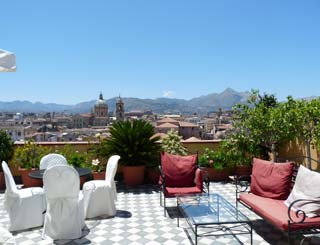
If you’re on a budget, using public transport and looking for convenient onward travel connections, the Albergo Cavour, close to the main railway station, is a good choice. For a stylish refuge in the heart of the city, try the Casa Nostra Boutique Hotel, which has a little garden terrace and hot tub. The Grand Hotel et Des Palmes offers the full old-style five-star experience, while the attractive Porta di Castro Boutique Hotel is a good-value mid-range option. I’ve stayed in the Hotel Ambasciatori, notable for its fine roof terrace – I found it decent, years ago, but recent reviews are lacklustre.
> Palermo accommodation – availability, reviews and booking
Palermo B&Bs
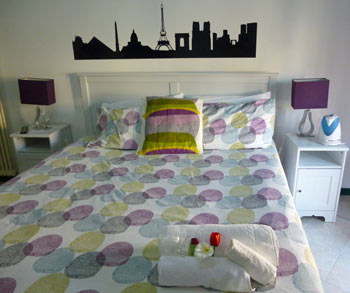
There are lots of newish B&Bs in town, and they can be affordable, friendly places to stay. If you choose a bed and breakfast option, make sure you read all the details carefully. There may be restrictions on check-in time, for example, and not all B&Bs offer luggage storage facilities or en-suite bathrooms. Check that there are lots of positive reviews before you make your booking. I’ve stayed comfortably at the Cosmopolitan B&B (pictured above) which was stylish and modern with a welcome tray (tea and cake) and a generous buffet breakfast. There was noise from a bar and traffic outside; though this is a risk anywhere in Palermo.
One very popular option is the B&B Family Affair Palermo, on the far side of town to Stazione Centrale, but only a few streets from an airport bus stop. Next to the station you’ll find the Calypso Il Binario Elegance, ideal for travellers in a hurry. As there are so many B&BS, dotted around the city, each with just a few rooms that are often sold out, your best bet is to use the availability search below, then filter by the best review ratings and look at a map to find the best options for your trip.
> B&Bs in Palermo
> Palermo accommodation search, with guest reviews and location maps.
Useful external links
Antica Focacceria San Francesco
Midnight in Sicily
Peter Robb’s account of Palermo, Sicily, cassata and organised crime
